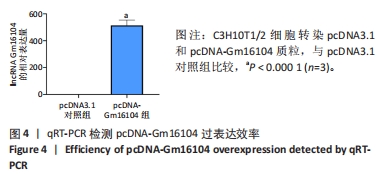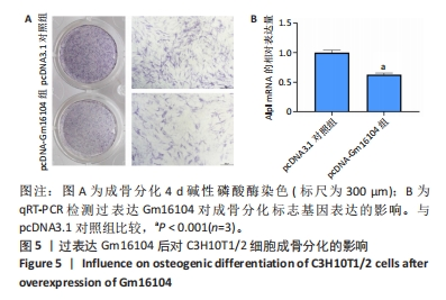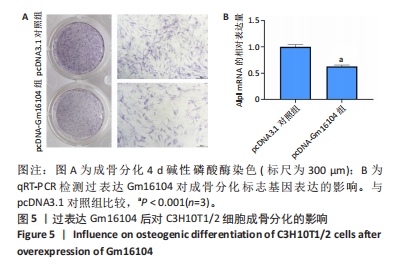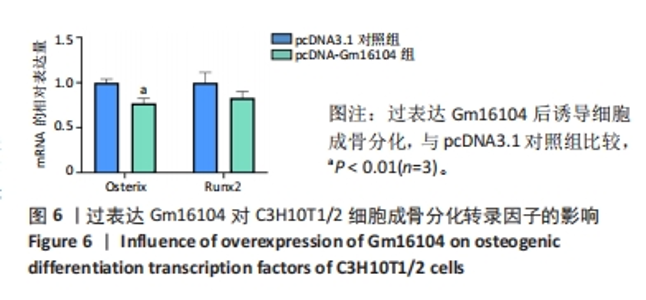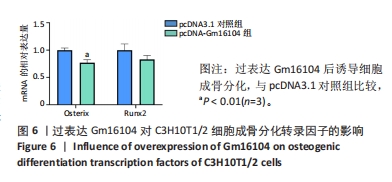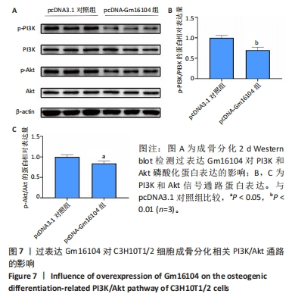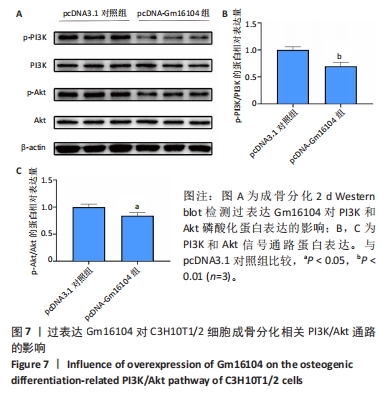Chinese Journal of Tissue Engineering Research ›› 2024, Vol. 28 ›› Issue (31): 4964-4969.doi: 10.12307/2024.710
Previous Articles Next Articles
Overexpression of long non-coding RNA Gm16104 affects osteogenic differentiation of C3H10T1/2 mesenchymal stem cells
Lin Zhanying, Lin Ziyun, Huang Liuyan, Zhang Wenxi, Zuo Changqing
- School of Pharmacy, Guangdong Medical University, Dongguan 523808, Guangdong Province, China
-
Received:2023-08-30Accepted:2023-09-22Online:2024-11-08Published:2024-01-22 -
Contact:Zuo Changqing, Associate professor, School of Pharmacy, Guangdong Medical University, Dongguan 523808, Guangdong Province, China -
About author:Lin Zhanying, Master candidate, School of Pharmacy, Guangdong Medical University, Dongguan 523808, Guangdong Province, China -
Supported by:Provincial Innovation Training Program for College Students, No. S202210571052 (to LZY); Guangdong Provincial Natural Science Foundation (General Program), No. 2017A030313641, No. 2018A0303130203 (to ZCQ)
CLC Number:
Cite this article
Lin Zhanying, Lin Ziyun, Huang Liuyan, Zhang Wenxi, Zuo Changqing. Overexpression of long non-coding RNA Gm16104 affects osteogenic differentiation of C3H10T1/2 mesenchymal stem cells[J]. Chinese Journal of Tissue Engineering Research, 2024, 28(31): 4964-4969.
share this article
Add to citation manager EndNote|Reference Manager|ProCite|BibTeX|RefWorks
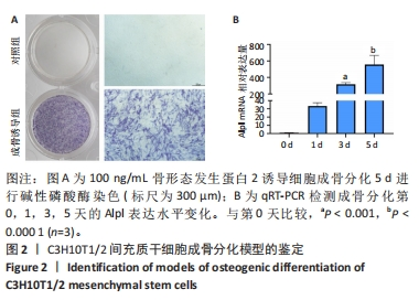
2.1 BMP-2可诱导C3H10T1/2间充质干细胞成骨分化 碱性磷酸酶在矿化组织细胞中高度表达,在骨的钙化过程起关键作用,是成骨细胞的表型标志物之一,根据碱性磷酸酶活性可判断细胞成骨分化程度[18-19]。该研究采用100 ng/mL BMP-2诱导细胞成骨分化,诱导5 d后进行碱性磷酸酶染色,结果显示:与对照组比较,诱导组80%以上细胞染色阳性呈紫蓝色,见图2A。提取成骨诱导第0,1,3,5天的细胞总RNA用于进行反转录反应,采用qRT-PCR检测成骨标志基因Alpl的表达水平,结果显示:在成骨分化过程中,Alpl的表达水平升高,见图2B,以上结果表明BMP-2可成功诱导C3H10T1/2细胞成骨分化。"
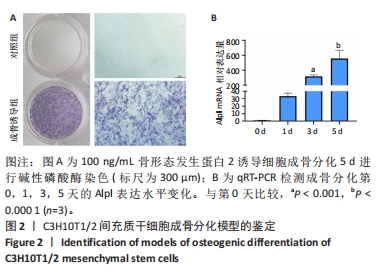
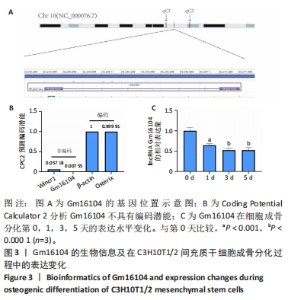
2.2 qRT-PCR鉴定Gm16104在成骨分化过程中的时序表达 在NCBI网站(https://www.ncbi.nlm.nih.gov/)上查询Gm16104的基因信息,见图3A。使用Coding Potential Calculator 2 (http://cpc2.gao-lab.org/)分析Gm16104的编码潜能,结果显示Gm16104不具有编码潜能,见图3B。前期通过lncRNA芯片筛选发现Gm16104在成骨分化过程中差异表达,进一步通过qRT-PCR检测Gm16104在成骨分化中时序表达。结果显示Gm16104在细胞成骨分化中表达水平逐渐降低,见图3C,表明Gm16104的表达在成骨分化中受到抑制。"
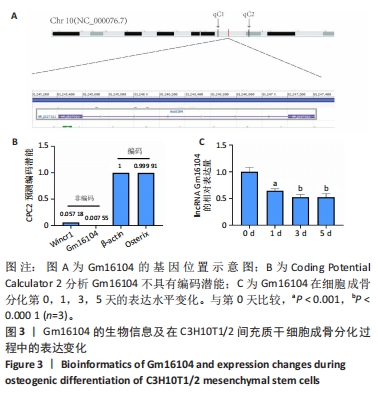
| [1] YI H, UR REHMAN F, ZHAO C, et al. Recent advances in nano scaffolds for bone repair. Bone Res. 2016;4:16050. [2] HERNIGOU P, POIGNARD A, MANICOM O, et al. The use of percutaneous autologous bone marrow transplantation in nonunion and avascular necrosis of bone. J Bone Joint Surg Br. 2005;87(7):896-902. [3] ZHA K, TIAN Y, PANAYI AC, et al. Recent Advances in Enhancement Strategies for Osteogenic Differentiation of Mesenchymal Stem Cells in Bone Tissue Engineering. Front Cell Dev Biol. 2022;10:824812. [4] CONFALONIERI D, SCHWAB A, WALLES H, et al. Advanced Therapy Medicinal Products: A Guide for Bone Marrow-derived MSC Application in Bone and Cartilage Tissue Engineering. Tissue Eng Part B Rev. 2018;24(2):155-169. [5] KHOSLA S, WESTENDORF JJ, OURSLER MJ. Building bone to reverse osteoporosis and repair fractures. J Clin Invest. 2008;118(2):421-428. [6] LIN S, MAEKAWA H, MOEINZADEH S, et al. An osteoinductive and biodegradable intramedullary implant accelerates bone healing and mitigates complications of bone transport in male rats. Nat Commun. 2023;14(1):4455. [7] SCARFÌ S. Use of bone morphogenetic proteins in mesenchymal stem cell stimulation of cartilage and bone repair. World J Stem Cells. 2016;8(1):1-12. [8] ENCODE PROJECT CONSORTIUM. An integrated encyclopedia of DNA elements in the human genome. Nature. 2012;489(7414):57-74. [9] DE LA FUENTE-HERNANDEZ MA, SARABIA-SANCHEZ MA, MELENDEZ-ZAJGLA J, et al. lncRNAs in mesenchymal differentiation. Am J Physiol Cell Physiol. 2022; 322(3):C421-C460. [10] BRIDGES MC, DAULAGALA AC, KOURTIDIS A. LNCcation: lncRNA localization and function. J Cell Biol. 2021;220(2):e202009045. [11] KOPP F, MENDELL JT. Functional Classification and Experimental Dissection of Long Noncoding RNAs. Cell. 2018;172(3):393-407. [12] WU Q, ZHANG H, YANG D, et al. The m6A-induced lncRNA CASC8 promotes proliferation and chemoresistance via upregulation of hnRNPL in esophageal squamous cell carcinoma. Int J Biol Sci. 2022;18(13):4824-4836. [13] AO X, DING W, LI X, et al. Non-coding RNAs regulating mitochondrial function in cardiovascular diseases. J Mol Med (Berl). 2023;101(5):501-526. [14] ZHANG W, ZHAO J, DENG L, et al. INKILN is a Novel Long Noncoding RNA Promoting Vascular Smooth Muscle Inflammation via Scaffolding MKL1 and USP10. Circulation. 2023;148(1):47-67. [15] WANG Z, ZHOU Y, DAI Z, et al. A Novel Long Noncoding RNA, Lnc-OAD, Is Required for Bone Morphogenetic Protein 2- (BMP-2-) Induced Osteoblast Differentiation. Biomed Res Int. 2021;2021:6697749. [16] CHEN Z, GAN L, CHEN X, et al. LncRNA HOTAIRM1 promotes dental follicle stem cell-mediated bone regeneration by regulating HIF-1α/KDM6/EZH2/H3K27me3 axis. J Cell Physiol. 2023;238(7):1542-1557. [17] ZUO C, WANG Z, LU H, et al. Expression profiling of lncRNAs in C3H10T1/2 mesenchymal stem cells undergoing early osteoblast differentiation. Mol Med Rep. 2013;8(2):463-467. [18] CROCKETT JC, ROGERS MJ, COXON FP, et al. Bone remodelling at a glance. J Cell Sci. 2011;124(Pt 7):991-998. [19] VIMALRAJ S. Alkaline phosphatase: Structure, expression and its function in bone mineralization. Gene. 2020;754:144855. [20] XIE Y, ZHOU J, TIAN L, et al. miR-196b-5p Regulates Osteoblast and Osteoclast Differentiation and Bone Homeostasis by Targeting SEMA3A. J Bone Miner Res. 2023;38(8):1175-1191. [21] YU R, HAN H, CHU S, et al. CUL4B orchestrates mesenchymal stem cell commitment by epigenetically repressing KLF4 and C/EBPδ. Bone Res. 2023; 11(1):29. [22] XU H, WANG C, LIU C, et al. Cotransplantation of mesenchymal stem cells and endothelial progenitor cells for treating steroid-induced osteonecrosis of the femoral head. Stem Cells Transl Med. 2021;10(5):781-796. [23] PONTING CP, OLIVER PL, REIK W. Evolution and functions of long noncoding RNAs. Cell. 2009;136(4):629-641. [24] AN F, WANG X, WANG C, et al. Research progress on the role of lncRNA-miRNA networks in regulating adipogenic and osteogenic differentiation of bone marrow mesenchymal stem cells in osteoporosis. Front Endocrinol (Lausanne). 2023;14:1210627. [25] LE G, LU M, LI L, et al. The Lnc-HOTAIR/miR122/PPARγ signaling mediated the occurrence and continuous development of alcohol-induced Osteonecrosis of the femoral head. Toxicol Lett. 2023;380:53-61. [26] PENG S, HE T, LIU Y, et al. Lnc-PPP2R1B Mediates the Alternative Splicing of PPP2R1B by Interacting and Stabilizing HNRNPLL and Promotes Osteogenesis of MSCs. Stem Cell Rev Rep. 2023;19(6):1981-1993. [27] TYE CE, GHULE PN, GORDON JAR, et al. LncMIR181A1HG is a novel chromatin-bound epigenetic suppressor of early stage osteogenic lineage commitment. Sci Rep. 2022;12(1):7770. [28] GAO H, DONG H, ZHENG J, et al. LINC01119 negatively regulates osteogenic differentiation of mesenchymal stem cells via the Wnt pathway by targeting FZD4. Stem Cell Res Ther. 2022;13(1):43. [29] NAKASHIMA K, ZHOU X, KUNKEL G, et al. The novel zinc finger-containing transcription factor osterix is required for osteoblast differentiation and bone formation. Cell. 2002;108(1):17-29. [30] ZHOU X, ZHANG Z, FENG JQ, et al. Multiple functions of Osterix are required for bone growth and homeostasis in postnatal mice. Proc Natl Acad Sci U S A. 2010; 107(29):12919-12924. [31] LIU Q, LI M, WANG S, et al. Recent Advances of Osterix Transcription Factor in Osteoblast Differentiation and Bone Formation. Front Cell Dev Biol. 2020;8: 601224. [32] HE S, YANG S, ZHANG Y, et al. LncRNA ODIR1 inhibits osteogenic differentiation of hUC-MSCs through the FBXO25/H2BK120ub/H3K4me3/OSX axis. Cell Death Dis. 2019;10(12):947. [33] SHEN J, SUN Y, LIU X, et al. EGFL6 regulates angiogenesis and osteogenesis in distraction osteogenesis via Wnt/β-catenin signaling. Stem Cell Res Ther. 2021;12(1):415. [34] LIU S, YAN X, GUO J, et al. Periodontal ligament-associated protein-1 knockout mice regulate the differentiation of osteoclasts and osteoblasts through TGF-β1/Smad signaling pathway. J Cell Physiol. 2023. doi: 10.1002/jcp.31062. [35] HUANG X, XIAO J, WANG H, et al. CKIP-1 mediates P. gingivalis-suppressed osteogenic/cementogenic differentiation of periodontal ligament cells partially via p38 signaling pathway. J Oral Microbiol. 2023;15(1):2236427. [36] CHEN X, CHEN W, AUNG ZM, et al. LY3023414 inhibits both osteogenesis and osteoclastogenesis through the PI3K/Akt/GSK3 signalling pathway. Bone Joint Res. 2021;10(4):237-249. [37] DE SANTIS MC, GULLUNI F, CAMPA CC, et al. Targeting PI3K signaling in cancer: Challenges and advances. Biochim Biophys Acta Rev Cancer. 2019;1871(2):361-366. [38] VANHAESEBROECK B, GUILLERMET-GUIBERT J, GRAUPERA M, et al. The emerging mechanisms of isoform-specific PI3K signalling. Nat Rev Mol Cell Biol. 2010;11(5):329-341. [39] SUN K, LUO J, GUO J, et al. The PI3K/AKT/mTOR signaling pathway in osteoarthritis: a narrative review. Osteoarthritis Cartilage. 2020;28(4):400-409. [40] GHOSH-CHOUDHURY N, ABBOUD SL, NISHIMURA R, et al. Requirement of BMP-2-induced phosphatidylinositol 3-kinase and Akt serine/threonine kinase in osteoblast differentiation and Smad-dependent BMP-2 gene transcription. J Biol Chem. 2002;277(36):33361-33368. [41] JING WB, JI H, JIANG R, et al. Astragaloside positively regulated osteogenic differentiation of pre-osteoblast MC3T3-E1 through PI3K/Akt signaling pathway. J Orthop Surg Res. 2021;16(1):579. |
| [1] | Chen Kaijia, Liu Jingyun, Cao Ning, Sun Jianbo, Zhou Yan, Mei Jianguo, Ren Qiang. Application and prospect of tissue engineering in treatment of osteonecrosis of the femoral head [J]. Chinese Journal of Tissue Engineering Research, 2024, 28(9): 1450-1456. |
| [2] | Wei Juan, Li Ting, Huan Mengting, Xie Ying, Xie Zhouyu, Wei Qingbo, Wu Yunchuan. Mechanism by which static exercise improves insulin resistance in skeletal muscle of type 2 diabetes [J]. Chinese Journal of Tissue Engineering Research, 2024, 28(8): 1271-1276. |
| [3] | Liu Xin, Hu Man, Zhao Wenjie, Zhang Yu, Meng Bo, Yang Sheng, Peng Qing, Zhang Liang, Wang Jingcheng. Cadmium promotes senescence of annulus fibrosus cells via activation of PI3K/Akt signaling pathway [J]. Chinese Journal of Tissue Engineering Research, 2024, 28(8): 1217-1222. |
| [4] | Wang Shanshan, Shu Qing, Tian Jun. Physical factors promote osteogenic differentiation of stem cells [J]. Chinese Journal of Tissue Engineering Research, 2024, 28(7): 1083-1090. |
| [5] | Pan Xiaolong, Fan Feiyan, Ying Chunmiao, Liu Feixiang, Zhang Yunke. Effect and mechanism of traditional Chinese medicine on inhibiting the aging of mesenchymal stem cells [J]. Chinese Journal of Tissue Engineering Research, 2024, 28(7): 1091-1098. |
| [6] | Ma Shuwei, He Sheng, Han Bing, Zhang Liaoyun. Exosomes derived from mesenchymal stem cells in treatment of animals with acute liver failure: a meta-analysis [J]. Chinese Journal of Tissue Engineering Research, 2024, 28(7): 1137-1142. |
| [7] | Feng Ruiqin, Han Na, Zhang Meng, Gu Xinyi, Zhang Fengshi. Combination of 1% platelet-rich plasma and bone marrow mesenchymal stem cells improves the recovery of peripheral nerve injury [J]. Chinese Journal of Tissue Engineering Research, 2024, 28(7): 985-992. |
| [8] | Wang Wen, Zheng Pengpeng, Meng Haohao, Liu Hao, Yuan Changyong. Overexpression of Sema3A promotes osteogenic differentiation of dental pulp stem cells and MC3T3-E1 [J]. Chinese Journal of Tissue Engineering Research, 2024, 28(7): 993-999. |
| [9] | Qiu Xiaoyan, Li Bixin, Li Jingdi, Fan Chuiqin, Ma Lian, Wang Hongwu. Differentiation of insulin-producing cells from human umbilical cord mesenchymal stem cells infected by MAFA-PDX1 overexpressed lentivirus [J]. Chinese Journal of Tissue Engineering Research, 2024, 28(7): 1000-1006. |
| [10] | Liu Qiwei, Zhang Junhui, Yang Yuan, Wang Jinjuan. Role and mechanism of umbilical cord mesenchymal stem cells on polycystic ovary syndrome [J]. Chinese Journal of Tissue Engineering Research, 2024, 28(7): 1015-1020. |
| [11] | Zhang Kefan, Shi Hui. Research status and application prospect of cytokine therapy for osteoarthritis [J]. Chinese Journal of Tissue Engineering Research, 2024, 28(6): 961-967. |
| [12] | Wei Yuanxun, Chen Feng, Lin Zonghan, Zhang Chi, Pan Chengzhen, Wei Zongbo. The mechanism of Notch signaling pathway in osteoporosis and its prevention and treatment with traditional Chinese medicine [J]. Chinese Journal of Tissue Engineering Research, 2024, 28(4): 587-593. |
| [13] | Gao Jie, , , Zou Xingxing, Wen Banghong, Li Yuandi, Su Min, , , Hu Rong, , . Effect of Pax6 gene expression on hydrogen peroxide-induced aging in bone marrow mesenchymal stem cells [J]. Chinese Journal of Tissue Engineering Research, 2024, 28(31): 4921-4925. |
| [14] | Zhao Wenjing, Liu Baikun, Li Qiulian, Chen Xi. Effects of long-term subculture on biological characteristics of bone marrow mesenchymal stem cells [J]. Chinese Journal of Tissue Engineering Research, 2024, 28(31): 4926-4930. |
| [15] | Shi Xian, Han Chunqing, Hu Anran, Kuang Shuyun, Ran Yimeng, Wu Yu. Atf7ip is a negative regulator of bone morphogenetic protein 2 promoting osteogenic differentiation in mouse embryonic adult cells [J]. Chinese Journal of Tissue Engineering Research, 2024, 28(31): 4931-4936. |
| Viewed | ||||||
|
Full text |
|
|||||
|
Abstract |
|
|||||

